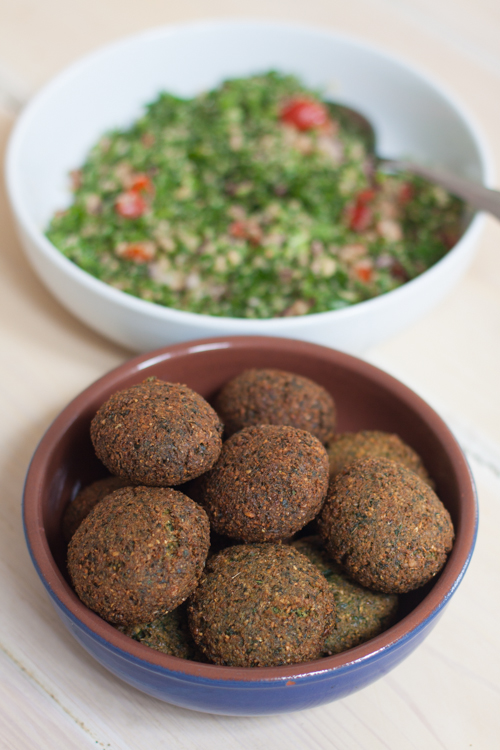
Falafel is one of those foods which you either love or hate. Or is it? I think the people who hate it just haven’t had the good stuff.
When falafel is bad, it is really bad – bland and dry, you might as well be eating cardboard. It is a pity that this is many people’s only experience of falafel, because the problem is so easily remedied; add more! More spices, more herbs, more garlic, more salt. This may seem obvious, but in practice more people turn out bland falafels, than aromatic and fragrant ones, so it is worth driving the point home.
At first glance, 4 tablespoons of cumin, 3 bunches of herbs, 6 cloves of garlic and 2 tablespoons of salt may seem excessive, but bear in mind that this falafel mixture makes 20 to 30 balls. You can test a small bit of the raw mixture, it won't hurt you, but if you don't want to do that, then fry a little piece to check it.
Assuming that most people do not have a deep fryer at home, I have given the instructions for shallow frying, but if you have access to a deep fryer, it is preferable.
As above, this mix makes 20-30 falafels, depending on the size. You can halve the mix if you don’t want so many or just cook what you need and freeze the leftover mixture for another time.
Falafel is most often consumed in a wrap, with sauces and salad. I usually serve it as part of a mezze selection with flatbread on the side so that people can make up their own mind whether to wrap it or fork it. Small falafels with tzatziki or hummous also make a great party snack.

Ingredients
500g dried chick peas, soaked overnight in cold water - don't use tinned, they won't hold together
4 tbsp cumin seed, toasted and ground
2 tbsp coriander seed, toasted and ground
1 red onion, roughly chopped
6 cloves garlic, roughly chopped
1 large bunch parsley, roughly chopped
1 large bunch coriander, roughly chopped
1 large bunch mint, roughly chopped
Pinch cayenne pepper
1 tsp bicarbonate soda
Freshly ground black pepper, to taste
1.5 - 2 tbsp of salt, to taste
Vegetable oil, for frying
Method
Drain the chick peas, rinse and put in a bowl. Add the rest of the ingredients, except for the salt and oil and stir to combine. Transfer portions of the mixture to a food processor and blend in batches. Blend until you have a thick paste; the mixture should not be completely smooth and uniform, but rather a pale green flecked with yellow chick peas and darker green herbs. Season with salt, to taste (you can taste the raw mixture or fry a small amount).
Roll the falafel mix into balls, slightly bigger than a golf ball, and place on a tray lined with baking paper.
Preheat the oven to 180C.
To shallow fry: fill a frying pan with 2cm vegetable oil and place over a high heat. To test the temperature, put a small pinch of the falafel mix in the oil - it should start sizzling instantly. Fry the falafel in small batches, pressing down when you put them in the pan, so that they colour more evenly. Fry for 2 to 3 minutes on each side or until golden brown. Transfer to a plate lined with kitchen roll to remove any excess oil and then put on a tray in the oven to keep warm while you fry the rest.
To deep fry: fill a deep saucepan with at least 10cm vegetable oil and place over a high heat. To test the temperature, put a small pinch of the falafel mix in the oil - it should start sizzling instantly. When you have the right temperature turn the heat down to medium. Gently lower the falafel balls into the oil in small batches, using a slotted metal spoon. Cook for 1-2 minutes or until golden brown. As above, transfer to a plate lined with kitchen roll to remove any excess oil and then put on a tray in the oven to keep warm while you fry the rest.

 Vix
Vix